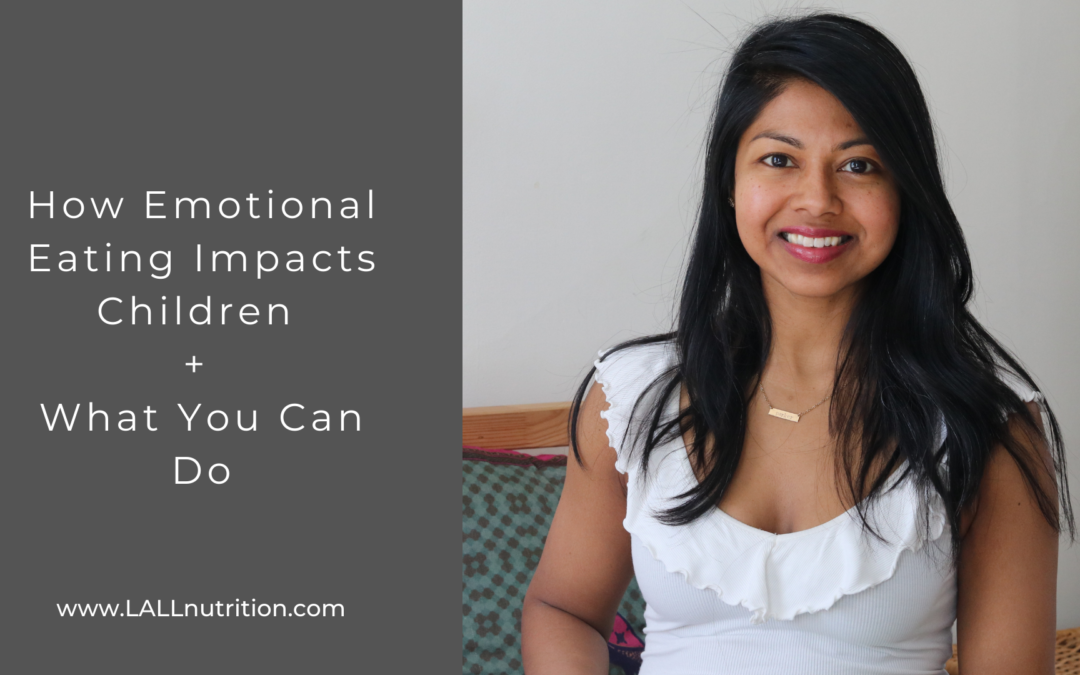Hello love,
Today I wanted to share more with you about how emotional eating impacts your kids and what you can do about it. I’ve gotten a few questions about it. Mothers have come to me worried that they’re going to pass on their emotional eating to their kids. It’s definitely something important to think about.
When you were younger…
Emotional eating is a pattern we learn when we are really young. If you’re an emotional eater, think back to when you were really young and you might notice that’s how your parents or caregivers dealt with their emotions. When things were uncomfortable or even great they emotionally ate. Perhaps you were sensitive and found that food could soothe you.
Food feels good. Food gives us a sense of nourishment from birth. It’s also a sense of bonding and love. So we look to food to fulfill that need. So we might have been an emotional eater, knowing that food gave us that comfort because it made us feel connected and nourished. When we have this pattern as a parent we can modelling this to our kids.
If you have the pattern, it’s possible that your children are going to model after you and have anxiety around food. Even if you tell them how to eat properly or show them they’re always going to be seeing your pattern and subconsciously absorbing it, especially if they’re really young.
Being proactive…
If you want to be proactive, it’s best that you get a handle on your emotional eating to be the best model for your kids. Children are going to do what you do, not what you say. I know this because I have a 6 year old and I can see all the things he does because I do it. He also has his autonomy and he wants to say no to certain foods. He has his own tastes and he has his own way of eating. It is different than me.
But if I wasn’t connected to my body then I would be really worried about him. I would put that on him, that something’s wrong with him. He’s getting the best quality foods but eats at different a different rhythm than me. That’s ok because I ask him questions about his body and his hunger. He’s also eating nourishing foods. I also teach him know the difference between nourishing foods and a treat.
The shifts
I’m going to share with you areas that you can start shifting so you can be the best role model for your kids, so that you’re not passing on your emotional eating.
The best thing you can do for your kids is be the best model for them. Show them that there’s possibility for them. Show them that you can have support and they can have a new way of looking at things. If we just try to do it ourselves or limit ourselves that’s what we are showing our kids as well. The areas that I’m going to share are key phases in my program. Take ideas from it that can help you.
Shift 1 – Nourishing Yourself
The first important area is learning how to truly nourish yourself. What I teach is how to truly nourish yourself, how to really tell when you’re emotionally hungry versus true hunger and how digestion is really key. Strategic digestion is key because when we’re nourishing ourselves, it doesn’t mean we’re putting good food into our body. It means we’re digesting the food. Even though we might eat great food, if we’re not digesting, absorbing and assimilating the food and the nutrients, we’re not absorbing the nutrients.
We’re not nourishing our body. When we’re strategic about our digestion and we know when we’re truly hungry versus emotionally hungry, this helps to support us.
Find a way to nourish your body that resonates with you and is sustainable. Focus in on how it feels to you, does it make sense to you? Is it sustainable or is it a 30 day diet? You can also learn about nutrition yourself. There’s so much nutritional noise but you can start educating yourself. But if you’re not interested in doing the research and need guidance, then look for support.
Look for someone who you can trust, give you results and tune in to you. What I find with a lot of emotional eating programs is that they don’t touch it on the nutrition and nourishment part. It’s really a foundation.
Shift 2 – Accepting Your Body
The second area is body acceptance. We don’t have to love our body, but we have to accept where it’s at. With emotional eaters we tend to be critical of our bodies and diet. We’re trying to control our eating and our body. We’re not the nicest people to our body. We don’t understand our body. So we might be dieting or trying to cut calories and we’re not giving to our body. We’re restricting from our body instead of giving our bodies the nourishment it needs or critical of our body. And so we punish it at the gym more. We are not giving ourselves quality foods. We might not be sleeping well or know that some days we’re going to eat more than others and that’s OK.
This is about body acceptance because our body’s needs change, especially if you’re a woman of reproductive age. It’s going to change throughout the month. So learning how to really accept your body and knowing how your body functions, it’s going to be important for you.
Shift 3 – Emotional Wellness
The third area is going to be emotional wellness. If you’re an emotional eater, you learn to use food to cope with your emotions. So now you need to learn how to actually be with your emotions and process through them.
If you were raised in a house that distracted from emotions or you didn’t feel safe around them support is important. Sometimes we need that additional support to go deeper to feel safe in our bodies, to process emotions. The way I work with emotions is on more of a somatic level because emotions live in our body. It’s not just about talking. We have the talking part and we have the emotional part and sensations.
We need to go deeper in the body to process out those emotions that are under the emotional eating in order to change the pattern. Support would be important here to move ingrained patterns. It’s hard to get out of a pattern yourself. You can but it will take a lot longer. I know, because I did it myself, it took me many, many years to figure out a way to really process through my emotions and to notice my triggers. With clients, this goes much faster. Look into getting emotional support.
Summary
These are the three key areas that are important for emotional eaters that I found in my own journey; truly nourishing my body, body acceptance and emotional wellness. Of course, there are other additional lifestyle factors we can add in, but those are the main ones. When we relearn a new way to do all those things, we start to move past our emotional eating. We start to feel comfortable in our body. We don’t feel as afraid around food and around our emotions.
When we embody the above our children will learn that naturally. They are absorbing how we are being not what we’re saying. We could say don’t have that treat. And then we’re eating all the treats and they see us doing that. It’s very confusing and chaotic.
We want to be the best role model we can be. No one is perfect, but we’re just doing the best that we can and our kids can see that. So those three areas are ways that you can help yourself, because when you help yourself, you’re going to be better able to help your kids. You’re going to have a better gauge of when they’re hungry, when they’re full, and you’re not going to be punishing them around food or restricting around food. You’re going to have better habits around that. When you embody it yourself, you become the model that you didn’t have growing up.
If this resonates with you and you want more support, then I invite you to book in an Emotional Eating Assessment Call to see if the Emotional Eating Evolution Program can support you and bridge the gap from where your are at and where you want to go.
To evolving,
Michelle
Certified Holistic Nutritionist + Emotional Eating Expert


